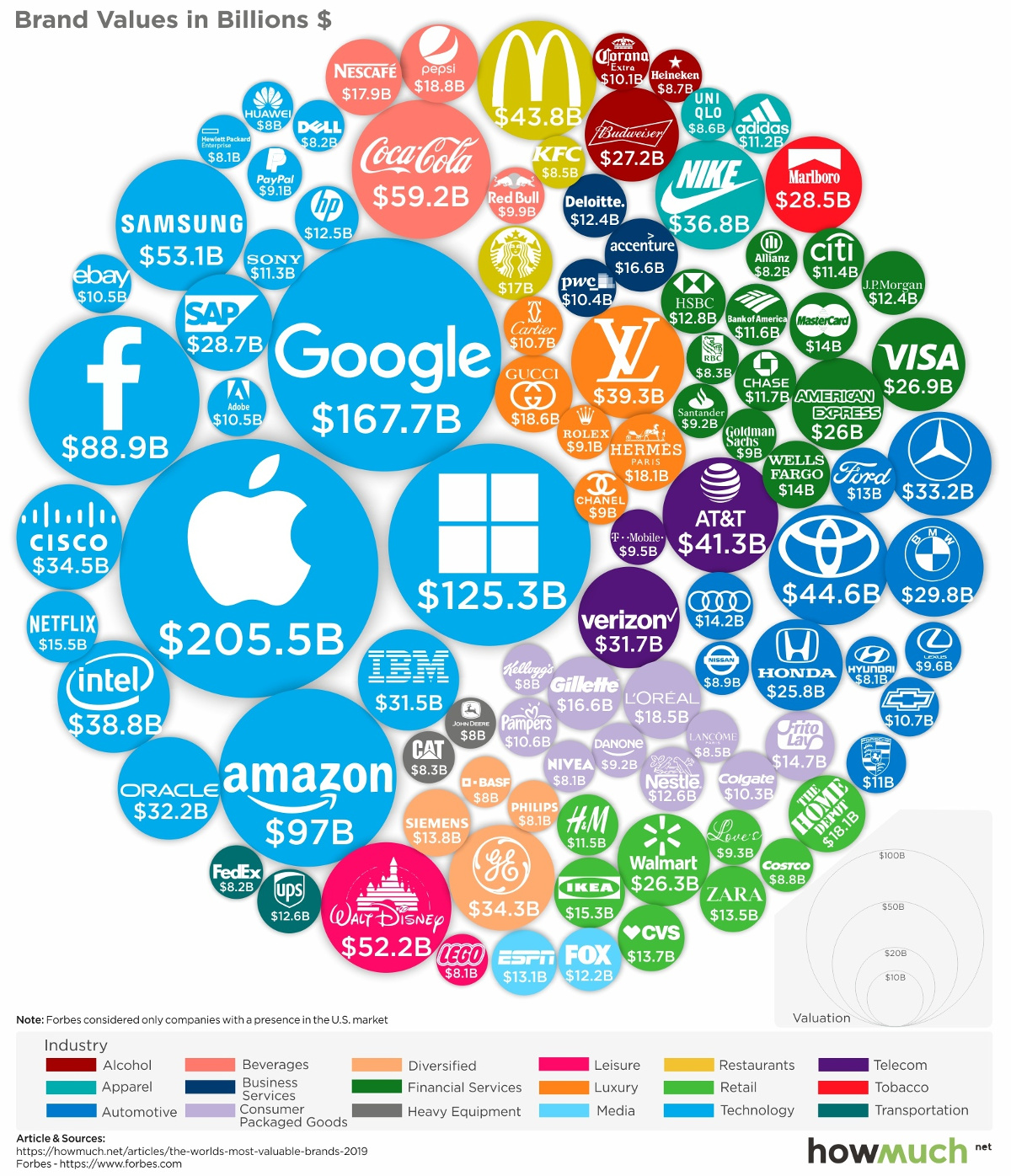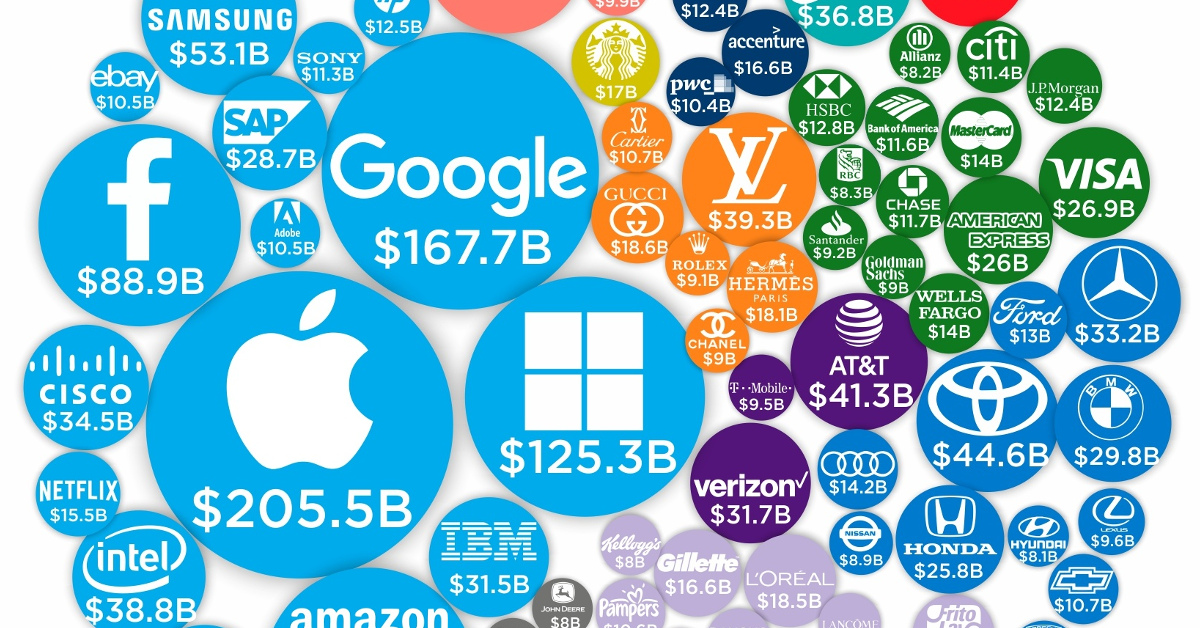Technology
The World’s 100 Most Valuable Brands in 2019

The World’s 100 Most Valuable Brands in 2019
Brand equity can be a challenging thing to build.
Even with access to deep pockets and an innovative product, it can take decades of grit to scrape your way into the mainstream consciousness of consumers.
On the path to becoming established as a globally significant brand, companies must fight through fierce competition, publicity scandals, changing regulations, and rapidly-evolving consumer tastes – all to take a bite from the same piece of pie.
Cream of the Crop
Today’s visualization comes to us from HowMuch.net, and it showcases the 100 most valuable brands in the world, according to Forbes.
Here are the powerful brands that sit at the very top of the list:
| Rank | Brand | Brand Value ($B) | 1-Yr Value Change | Industry |
|---|---|---|---|---|
| #1 | Apple | $205.5 | +12% | Technology |
| #2 | $167.7 | +27% | Technology | |
| #3 | Microsoft | $125.3 | +20% | Technology |
| #4 | Amazon | $97.0 | +37% | Technology |
| #5 | $88.9 | -6% | Technology | |
| #6 | Coca-Cola | $59.2 | +3% | Beverages |
| #7 | Samsung | $53.1 | +11% | Technology |
| #8 | Disney | $52.2 | +10% | Leisure |
| #9 | Toyota | $44.6 | +0% | Automotive |
| #10 | McDonald's | $43.8 | +6% | Restaurants |
It should be noted that the list is ordered by brand value, a measure that tries to calculate each brand’s ultimate contribution in financial terms to the parent company. You can see that full methodology here.
Finally, it’s also worth mentioning that brands with only a token representation in the United States have been excluded from the rankings. This means companies like Alibaba or Vodafone are not represented in this particular visualization.
Tech Rules Again in 2019
For another straight year, technology dominates the list of the 100 most valuable brands in 2019 – this time, with six of the top seven entries.
Most of these brands saw double-digit growth in value from the previous year, including Apple (12%), Google (27%), Amazon (37%), Microsoft (20%), and Samsung (11%). The one notable exception here is Facebook, which experienced a 6% drop in value attributed to various struggles around the company’s reputation.
Here’s a look at how industries break down more generally on the list:
| Industry | # of Brands | Brand Value ($B) |
|---|---|---|
| Technology | 20 | $957.6 |
| Financial Services | 13 | $198.1 |
| Automotive | 11 | $208.9 |
| Consumer Goods | 10 | $123.8 |
| Retail | 8 | $133.0 |
| Luxury | 6 | $124.1 |
| Beverages | 4 | $49.3 |
| Diversified | 4 | $56.8 |
| Alcohol | 3 | $69.8 |
| Apparel | 3 | $34.7 |
| Business Services | 3 | $33.5 |
| Restaurants | 3 | $73.0 |
| Telecom | 3 | $24.3 |
| Heavy Equipment | 2 | $36.7 |
| Leisure | 2 | $19.8 |
| Media | 2 | $34.8 |
| Transportation | 2 | $41.1 |
| Tobacco | 1 | $12.6 |
| Total | 100 | $2,231.9 |
As you can see, technology brands make up 20% of the list in terms of the number of entries – and a whopping 43% of the list’s cumulative valuation.
In total, technologies brands combined for $957.6 billion in value. Even when including Facebook’s recent drop, this is an impressive 9.7% increase on last year’s numbers.
Will the double-digit increases for the world’s largest tech giants continue into 2020, or are brands such as Amazon and Google going to start seeing the same type of pushback that Facebook has grappled with among consumers and regulators?
Technology
All of the Grants Given by the U.S. CHIPS Act
Intel, TSMC, and more have received billions in subsidies from the U.S. CHIPS Act in 2024.

All of the Grants Given by the U.S. CHIPS Act
This was originally posted on our Voronoi app. Download the app for free on iOS or Android and discover incredible data-driven charts from a variety of trusted sources.
This visualization shows which companies are receiving grants from the U.S. CHIPS Act, as of April 25, 2024. The CHIPS Act is a federal statute signed into law by President Joe Biden that authorizes $280 billion in new funding to boost domestic research and manufacturing of semiconductors.
The grant amounts visualized in this graphic are intended to accelerate the production of semiconductor fabrication plants (fabs) across the United States.
Data and Company Highlights
The figures we used to create this graphic were collected from a variety of public news sources. The Semiconductor Industry Association (SIA) also maintains a tracker for CHIPS Act recipients, though at the time of writing it does not have the latest details for Micron.
| Company | Federal Grant Amount | Anticipated Investment From Company |
|---|---|---|
| 🇺🇸 Intel | $8,500,000,000 | $100,000,000,000 |
| 🇹🇼 TSMC | $6,600,000,000 | $65,000,000,000 |
| 🇰🇷 Samsung | $6,400,000,000 | $45,000,000,000 |
| 🇺🇸 Micron | $6,100,000,000 | $50,000,000,000 |
| 🇺🇸 GlobalFoundries | $1,500,000,000 | $12,000,000,000 |
| 🇺🇸 Microchip | $162,000,000 | N/A |
| 🇬🇧 BAE Systems | $35,000,000 | N/A |
BAE Systems was not included in the graphic due to size limitations
Intel’s Massive Plans
Intel is receiving the largest share of the pie, with $8.5 billion in grants (plus an additional $11 billion in government loans). This grant accounts for 22% of the CHIPS Act’s total subsidies for chip production.
From Intel’s side, the company is expected to invest $100 billion to construct new fabs in Arizona and Ohio, while modernizing and/or expanding existing fabs in Oregon and New Mexico. Intel could also claim another $25 billion in credits through the U.S. Treasury Department’s Investment Tax Credit.
TSMC Expands its U.S. Presence
TSMC, the world’s largest semiconductor foundry company, is receiving a hefty $6.6 billion to construct a new chip plant with three fabs in Arizona. The Taiwanese chipmaker is expected to invest $65 billion into the project.
The plant’s first fab will be up and running in the first half of 2025, leveraging 4 nm (nanometer) technology. According to TrendForce, the other fabs will produce chips on more advanced 3 nm and 2 nm processes.
The Latest Grant Goes to Micron
Micron, the only U.S.-based manufacturer of memory chips, is set to receive $6.1 billion in grants to support its plans of investing $50 billion through 2030. This investment will be used to construct new fabs in Idaho and New York.
-

 Education1 week ago
Education1 week agoHow Hard Is It to Get Into an Ivy League School?
-

 Technology2 weeks ago
Technology2 weeks agoRanked: Semiconductor Companies by Industry Revenue Share
-

 Markets2 weeks ago
Markets2 weeks agoRanked: The World’s Top Flight Routes, by Revenue
-

 Demographics2 weeks ago
Demographics2 weeks agoPopulation Projections: The World’s 6 Largest Countries in 2075
-

 Markets2 weeks ago
Markets2 weeks agoThe Top 10 States by Real GDP Growth in 2023
-

 Demographics2 weeks ago
Demographics2 weeks agoThe Smallest Gender Wage Gaps in OECD Countries
-

 Economy2 weeks ago
Economy2 weeks agoWhere U.S. Inflation Hit the Hardest in March 2024
-

 Environment2 weeks ago
Environment2 weeks agoTop Countries By Forest Growth Since 2001












